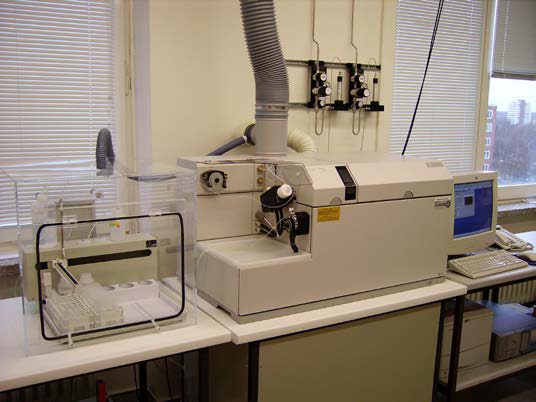AGILENT 7500cs ICP-mass spectrometer (ICP-MS)
Instrument
Quadrupole-based ICP-mass spectrometer
Technical Data/Features
- octopole reaction cell (ORS) for removal of spectral interferences (c mode)
- second vacuum pump for enhanced detection power (s mode)
- Pt interface
Inductively coupled plasma à mass spectrometry (ICP-MS) is a powerful method for the determination of the (trace) element chemical composition of a sample. A mass spectrometer (MS) separates ionized elements and isotopes according to their mass-to-charge ratio (m/z) for subsequent quantification. Samples are introduced as liquids after pneumatic nebulization, or as dry aerosols after desolvation or laser ablation. The inductively coupled argon plasma (ICP) with temperatures of ?6000 K is the ion source of the MS. Ions formed in the ICP are extracted through the interface into the high vacuum part of the MS and focused towards the quadrupole mass filter by ion optics (electrostatic lenses and octopole). The octopole reaction system (ORS) accomplishes collisions or reactions of interfering molecular ions with a gas phase (typically He, H2) for a reduction of spectral interferences from polyatomic ions. The subsequent quadrupole acts like a band-pass filter allowing transmission of ions with a given m/z ratio at a time. The mass resolution is 1- 0.5 mass units. A quadrupole allows very rapid scanning over the entire mass range (6-238 m/z) within <200ms. The detector (secondary electron multiplier, SEM) converts ion counts into electrical pulses (pulse counting mode) and/ or an electrical current (analog mode). The dynamic range of the SEM is 109 CPS. This signal (in counts per second, CPS) is recorded for each analysed isotope and transmitted to computer software for conversion into quantitative results (e.g., ?g/L) after calibration with pre-defined calibration standards. ICP-MS is a very rapid and extremely sensitive multi-element analytical method. Almost all elements of the PSE from Li to U (not: H, C, O, N, noble gases) can be analysed with typical limits of detection in the ng/L (ppt) range and below. However, ICP-MS is prone to mass spectral interferences that have to be identified and corrected for. Alternative sample introduction systems (see ÃAccessoriesÃ) allow the analysis of ultra-small sample volumes <100?L (dedicated PFA micro-nebulizers), the reduction of interferences from oxide polyatomic ions (desolvating nebulizer), and the on-line chromatographic separation of sample matrix components (SeaFAST system) as in e.g., seawater.
Applications
This instrument is routinely used for liquid sample introduction. Major routine application fields are:
- Simultaneous determination of 45 trace and ultra-trace elements in geological and extra-terrestrial samples (as solutions after applying appropriate sample preparation protocols). Detection limits in the low ppb-range, external precision and accuracy <1-3%, sub-mg sample weights
- Trace and ultra-trace-elements in groundwater, seawater, hydrothermal fluids etc
- Trace elements in life science and pharmaceutical samples
- Chemical composition of high-tech materials
Keywords
Mass Spectrometry, Isotope and Trace Element Analysis, Materials Analysis

